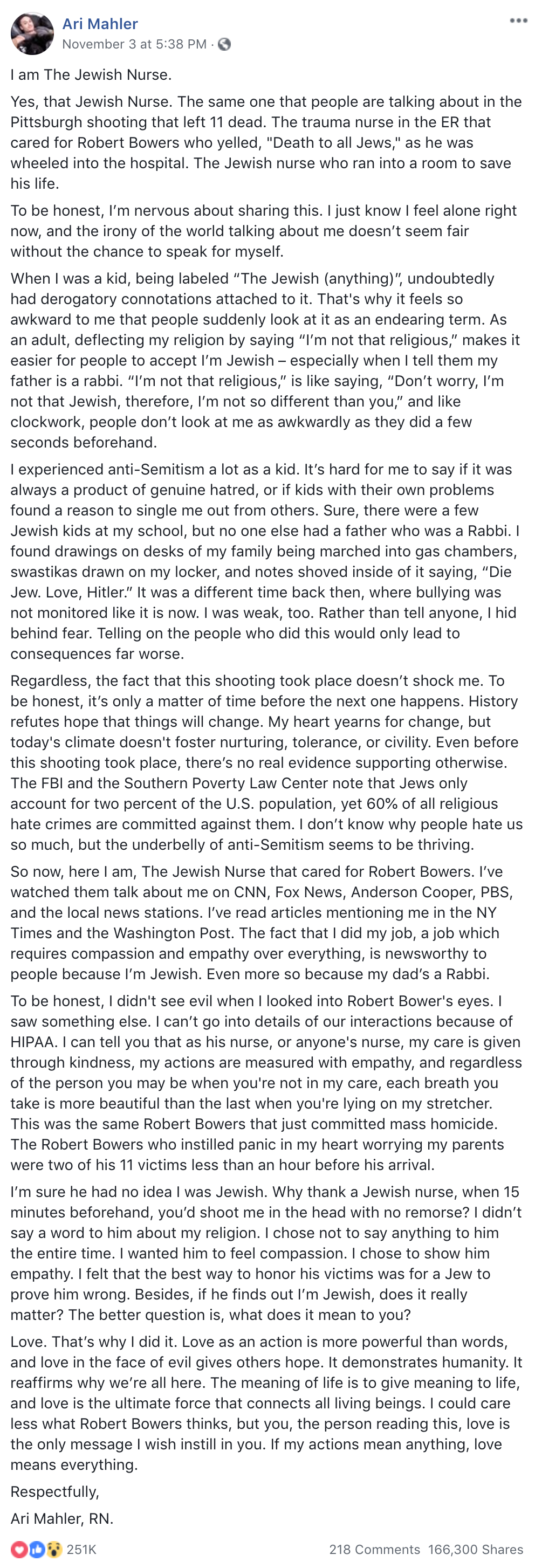From Nurse Keith’s Digital Doorway
In the course of many nurses’ healthcare careers, witnessing the illness, suffering, and death of others is commonplace. From dialysis and med-surg to home health and the ICU, nurses create therapeutic relationships with patients and their families, providing spiritual and emotional comfort, compassion, and expert skilled care based on many decades of nursing science and evidence-based interventions.
Aside from witnessing the challenges faced by others, nurses are themselves human beings with their own life experiences, victories, and suffering. How a nurse navigates their own personal suffering plays a role in determining how they approach life, work, and the overlapping of the two.
Life is Suffering
In Buddhist studies, it has been said that life is suffering. I believe that this expression refers to the notion that our emotional attachment to the things that make up our lives (relationships, money, success, possessions, family) are what cause us suffering, and the ability to live in the present without grasping for what we don’t already have can help to alleviate that suffering. In other words, our desires cause us to suffer.
Aside from our attachment to things and people, there is also the reality that bad things often happen to good people — we see children with incurable cancer, elders living alone and destitute, and many other situations that seem both untenable and patently unfair.
In nursing, medicine, and healthcare, what we’re grasping for is the health and well-being of our patients, sometimes against all odds. We grow attached to patients and their families, our compassion goes out to them in their hour of need, and we can feel like failures when things don’t go the way we wished they would.
I’ve lost many patients over the years, and I did indeed sometimes blame myself when they suffered or died, especially when it seemed almost impossible to alleviate their suffering. I’ve seen patients consumed by cancer, heart or liver disease, dementia, stroke, multiple sclerosis, ALS, diabetes, and the opportunistic infections that transform an HIV+ patient into someone living with AIDS.
Suffering is also witnessed by so many of us when we turn on the evening news, listen to the radio, or scroll through a news app on our phone or our Facebook feed. War, famine, terrorism, politics, the economy — each of these aspects of 21st-century life can reveal to us the crueler side of human nature and existence.
Our Own Suffering
I’ve lived with chronic pain for more than a dozen years, and I admittedly suffer to some degree every day. Like many other people with physical pain, I power through my days and then rest at night as best I can.
Throughout my many years of providing career coaching and professional support to nurses, I’ve heard many stories that have nearly broken my heart. Nurses with all manner of conditions have passed through my orbit, and I’m consistently inspired by the courage and persistence embodied by these incredibly strong human beings. From burnout and depression to cancer and brain trauma, nurses are themselves patients too.
As nurses who serve the ill, injured, and vulnerable, how do we tend to our own suffering while also being present for our patients? How do we allow ourselves the space to feel our own feelings and deal with our personal issues without feeling guilty for being vulnerable ourselves?
Nurses often feel they need to be invincible, uncomplaining, and stoic, but we’re human beings, not angels and saints. We nurses need to honor our own suffering, challenges, and pain — by doing so, we can then be even more available for our patients through the simple fact of our own compassionate understanding of their plight and our very human experience.
Our Own Humanity
As nurses, healthcare professionals, and human beings living in a complex and often stressful 21st-century world, our own humanity matters, even when we’re determined to deny our own pain and suffering in the interest of being the strong nurse helping others. Denying our humanity and our pain does us no good, but nurses are experts at doing so.
We nurses are fallible and prone to all of the ills that are visited upon our fellow citizens. Like everyone else, we have our existential anxieties about family and friends, the environment, politics, our finances, our futures, our careers, and anything else under the sun.
Nurses too live with debt, personal tragedy, and grief and loss — we also strive to create the best lives we possibly can for ourselves, our loved ones, and our communities. At times, admitting that we don’t have the answers is a very human thing to do. The ability to say “I don’t know” is a sign of strength, even for a nurse who prides herself on always having the answers to life’s vexing questions.
Our humanity has meaning, no matter our efforts to be superhuman and carry the weight of the world on our shoulders. As nurses, we must strive to recognize, accept, and celebrate our own fallibility, and create lifestyles and careers that honor our needs, our pain, our suffering, and the forward thinking personal and professional lives we strive to live.
Keith Carlson, RN, BSN, NC-BC, is the Board Certified Nurse Coach behind NurseKeith.com and the well-known nursing blog, Digital Doorway. Please visit his online platforms and reach out for his support when you need it most.
Keith is co-host of RNFMRadio.com, a wildly popular nursing podcast; he also hosts The Nurse Keith Show, his own podcast focused on career advice and inspiration for nurses.
A widely published nurse writer, Keith is the author of “Savvy Networking For Nurses: Getting Connected and Staying Connected in the 21st Century,” and has contributed chapters to a number of books related to the nursing profession. Keith has written for Nurse.com, Nurse.org, MultiViews News Service, LPNtoBSNOnline, StaffGarden, AusMed, American Sentinel University, the ANA blog, Working Nurse Magazine, and other online publications.
Mr. Carlson brings a plethora of experience as a nurse thought leader, online nurse personality, podcaster, holistic career coach, writer, and well-known successful nurse entrepreneur. He lives in Santa Fe, New Mexico with his lovely and talented wife, Mary Rives.
Disclaimer: The viewpoint expressed in this article is the opinion of the author and is not necessarily the viewpoint of the owners or employees at Healthcare Staffing Innovations, LLC.










